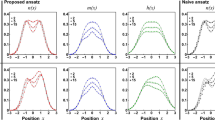Abstract
We consider two models for a pair of interacting particles in a random potential: (i) two particles with a Hubbard interaction in arbitrary dimensions and (ii) a strongly bound pair in one dimension. Establishing suitable correspondences we demonstrate that both cases can be described in terms familiar from theories of non-interacting particles. In particular, these two cases are shown to be controlled by a single scaling variable, namely the pair conductance g 2. For an attractive or repulsive Hubbard interaction and starting from a certain effective Hamiltonian we derive a supersymmetric nonlinear σ model. Its action turns out to be closely related to the one found by Efetov for noninteracting electrons in disordered metals. This enables us to describe the diffusive motion of the particle pair on scales exceeding the oneparticle localization length L 1 and to discuss the corresponding level statistics. For tightly bound pairs in one dimension, on the other hand, we follow early work by Dorokhov and exploit the analogy with the transfer matrix approach to quasi-1d conductors. Extending our study to M particles we obtain a M-particle localization length scaling like the Mth power of the one-particle localization length.
Similar content being viewed by others
Author information
Authors and Affiliations
Rights and permissions
About this article
Cite this article
Frahm, K., Müller-Groeling, A. & Pichard, JL. Two interacting particles in a random potential: mapping onto one parameter localization theories without interaction. Z. Phys. B 102, 261–275 (1997). https://doi.org/10.1007/s002570050288
Received:
Published:
Issue Date:
DOI: https://doi.org/10.1007/s002570050288



